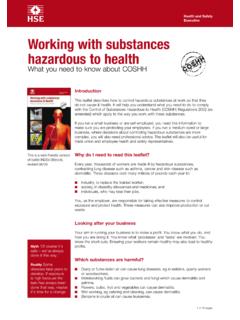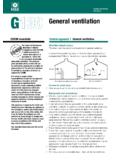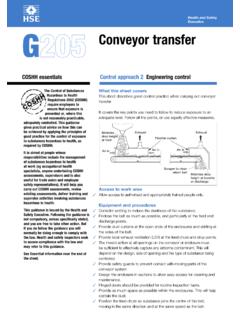Transcription of Health and Safety SR1111 Hairdressing - Coshh Essentials
1 Health and Safety Executive Hairdressing SR1. 11. Coshh Essentials for service and retail Harm via skin or eye contact 3. This information will help Access and premises 3. employers (including the Keep the workplace well ventilated, with a through draught. self-employed and Provide good washing facilities. franchisees) comply with 3. the Control of Substances Personal protective equipment (PPE). Hazardous to Health Regulations 2002 Ask your supplier to help you get the right 3. ( Coshh ), as amended, to control exposure PPE. and protect workers' Health . It is also Provide protective gloves - select powder-free 3. useful for trade union Safety vinyl gloves 300 mm long. representatives. Throw away single-use gloves every time they 3. are taken off. This sheet describes good practice. It Skin creams are important for skin condition. covers the points you need to follow to They help in washing contamination from the reduce exposure to an adequate level. It is skin. After-work creams help to replace skin important to follow all the points, or use oils.
2 Equally effective measures. Caution: barrier creams' do not make a full Read labels and instructions for use. barrier. For cosmetic products - cross-check 3. manufacturers' product lists with the Procedures 3. booklet A Guide to the Health and If possible, avoid dusty products - buy granules, pastes or solutions. Safety of Salon Hair Products' and Store products securely in a cool, dry, dark place, capable of keeping 3. follow its guidelines (see Further in spills. Don't store far more than you need. information). For other products, eg Read the instructions on labels carefully - follow the instructions for 3. disinfectants, get a Safety data sheet from use. your supplier and seek safer substitutes. Keep products off your skin - wear gloves and wash off any splashes 3. immediately. Prevent dermatitis developing. 3. Make up only as much solution as you will need for immediate use. Prevent exposure to substances that can Dispose of safely all products you no longer need. cause asthma, and control exposure to stop 3.
3 Asthma attacks. Special care 3. Skin contact with products may cause dermatitis. Main points Wet work - hand immersion, particularly frequent contact with water n 3. Frequent wet work can cause and soap or detergent also causes dermatitis. Dry hands thoroughly. dermatitis. Some hair dyes can pass through skin. Wear gloves for washing off, n 3. Some hair products can cause allergic too. reactions (asthma and dermatitis). Some dusty ingredients, eg persulphates and henna, may cause n 3. Check that all the controls are being asthma. Use dust-free products. used properly. Some hairspray products can make existing asthma worse. 3. Maintenance, examination and testing Wash out mixing equipment after use. Dispose of this waste liquid safely. Service and retail SR11 Harm via skin or eye contact 3. Health surveillance Check if any information about the product says may cause sensitisation by skin contact' or can cause allergic reactions'. If so, or there is extensive wet work, do Health surveillance for dermatitis - see 3.
4 Sheet G403. Dry hands thoroughly after any wet work. Ask workers to check their skin for dryness or soreness every month, if they are not under Health 3. surveillance. There is a chance of asthma developing through work with some types of product. Check if any information about the product says may cause sensitisation by inhalation' or can cause allergic reactions'. If so, do Health surveillance for asthma - see sheet G402. 3. Cleaning and housekeeping 3. Keep the work area clean. 3. Disinfect shower heads once a week. 3. Clean up spills promptly - practise how to do this. Dispose of empty containers and wastes safely. 3. Training and supervision Tell workers about the risks of using the product - see products labels 3. or the supplier's Safety information. Working in the right way and using the controls correctly is important for exposure control. Train and supervise workers. See sheet SR0. Further information n A Guide to the Health and Safety of Salon Hair Products Available from hair product manufacturers or the Hair & Beauty Suppliers Association.
5 Hair product manufacturers also supply their customers with product lists that go with the guide. n Assessing and managing risks at work from skin exposure to chemical agents: Guidance for employers and Health and Safety specialists HSG205 HSE Books 2001 ISBN 0 7176 1826 9. n Preventing dermatitis at work: Advice for employers and employees Leaflet INDG233 HSE Books 1996 (single copy free or priced packs of 15 ISBN 0 7176 1246 5). n Preventing asthma at work. How to control respiratory sensitisers L55. HSE Books 1994 ISBN 0 7176 0661 9. n Posters on protective gloves and skin care - see n Health surveillance for dermatitis - see Service and retail SR11 Harm via skin or eye contact Useful links Employee checklist n HSE priced and free publications are available from HSE Books If you find any problems, Tel: 01787 881165 Website: tell your supervisor. Don't n For information about Health and Safety ring HSE's Infoline Tel: 0845. just carry on working. 345 0055 Textphone: 0845 408 9577 e-mail: n Contact the British Occupational Hygiene Society (BOHS) on 01332 Dry your hands 298101 or at for lists of qualified hygienists who can thoroughly after washing.
6 Help you. Avoid long periods of work n Look in the Yellow Pages under Health and Safety consultants' and with your hands wet. Health authorities and services' for occupational Health '. Use skin creams provided n Also see as often as possible. Never clean your hands with concentrated cleaning products or solvents. Throw away single-use gloves every time you take them off. Cooperate with Health surveillance. Check your skin regularly for dryness or soreness - tell your supervisor if these symptoms appear. This guidance is issued by the Health and Safety Executive. Following the guidance is not compulsory and you are free to take other action. But if you do follow the guidance you will normally be doing enough to comply with the law. Health and Safety inspectors seek to secure compliance with the law and may refer to this guidance as illustrating good practice. Published by the Health and Safety Executive 10/06.












